Abstract
Analysis of cosmid clones containing genes related to the HLA-DR alpha chain calls for at least six HLA-D region alpha-chain coding sequences in man; namely, DR alpha, DC alpha, DX alpha (very closely related to DC alpha), SB alpha 1, SB alpha 2 (two closely linked genes on the same cosmid clones), and DZ alpha. The first four genes have been described previously. SB alpha 2 and DZ alpha are recently identified genes, characterized by their unique and, from a limited study, nonpolymorphic bands when used as probes for human DNA on Southern blots. All of the genes are present in somatic cell hybrids containing a human X/6 translocation chromosome, and so they are all presumably in the HLA region. The polymorphisms in the region of the DC alpha and related DX alpha genes were studied with Southern blots of DNA from a set of mostly homozygous HLA-D-typing cell lines. With EcoRI, the band patterns for the DC alpha gene corresponded to the major cross-reactive HLA-DR serotypes associated with DC (namely MT1, -2, and -3) while the DX alpha band was invariant. Both genes were polymorphic with the enzyme Taq I. Within some DR types additional polymorphic variation was detected at the DNA level, implying the existence of subtypes. The pattern of polymorphisms for DC alpha, and to a lesser extent for DX alpha, suggests that these genes may play an important role in certain HLA-D associations with disease.
Full text
PDF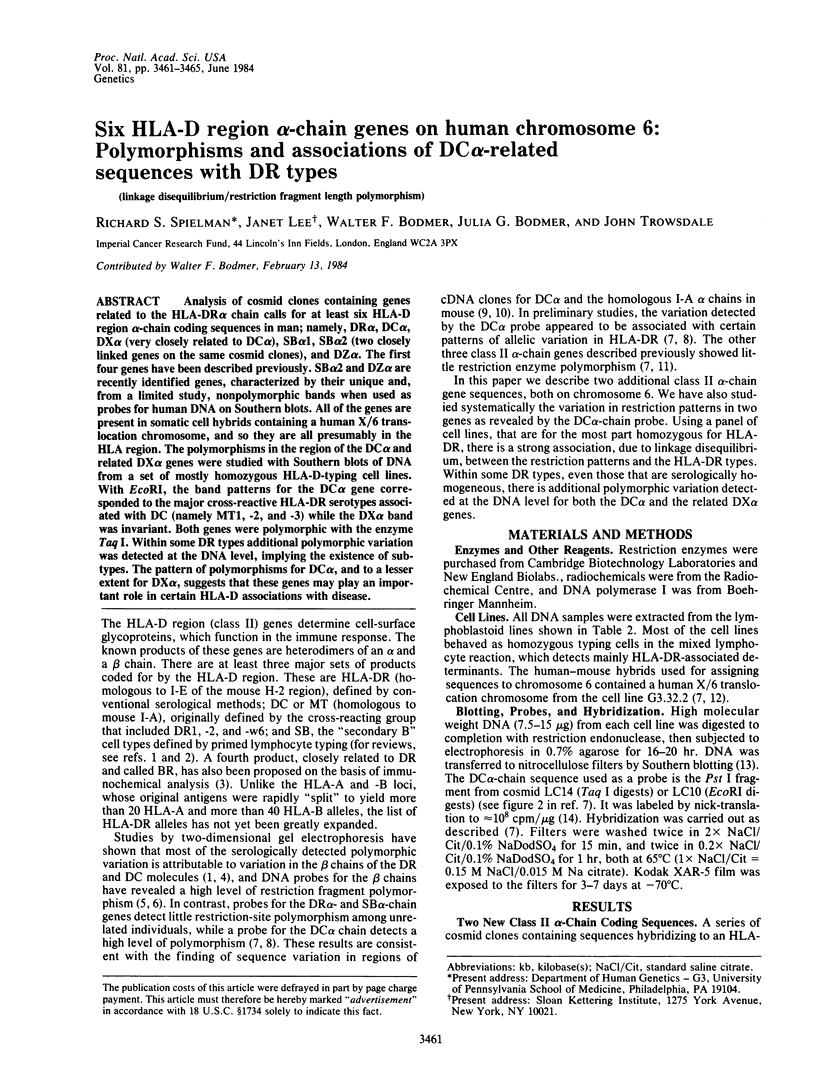
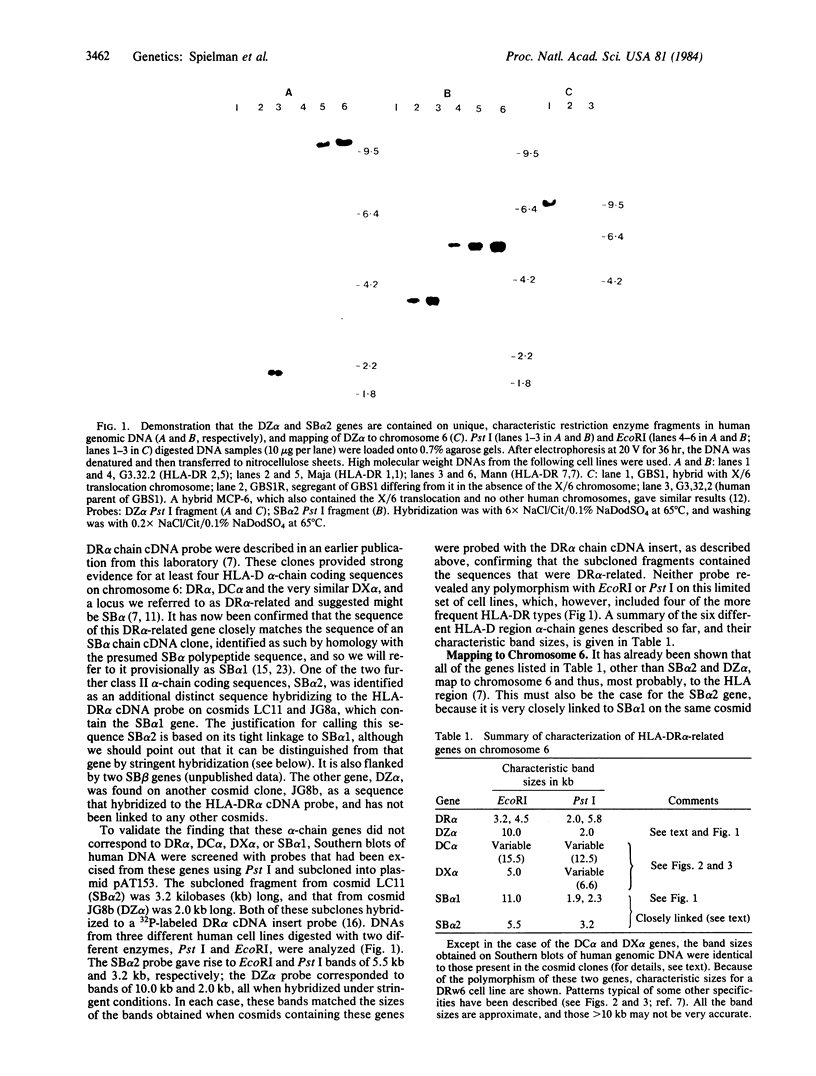
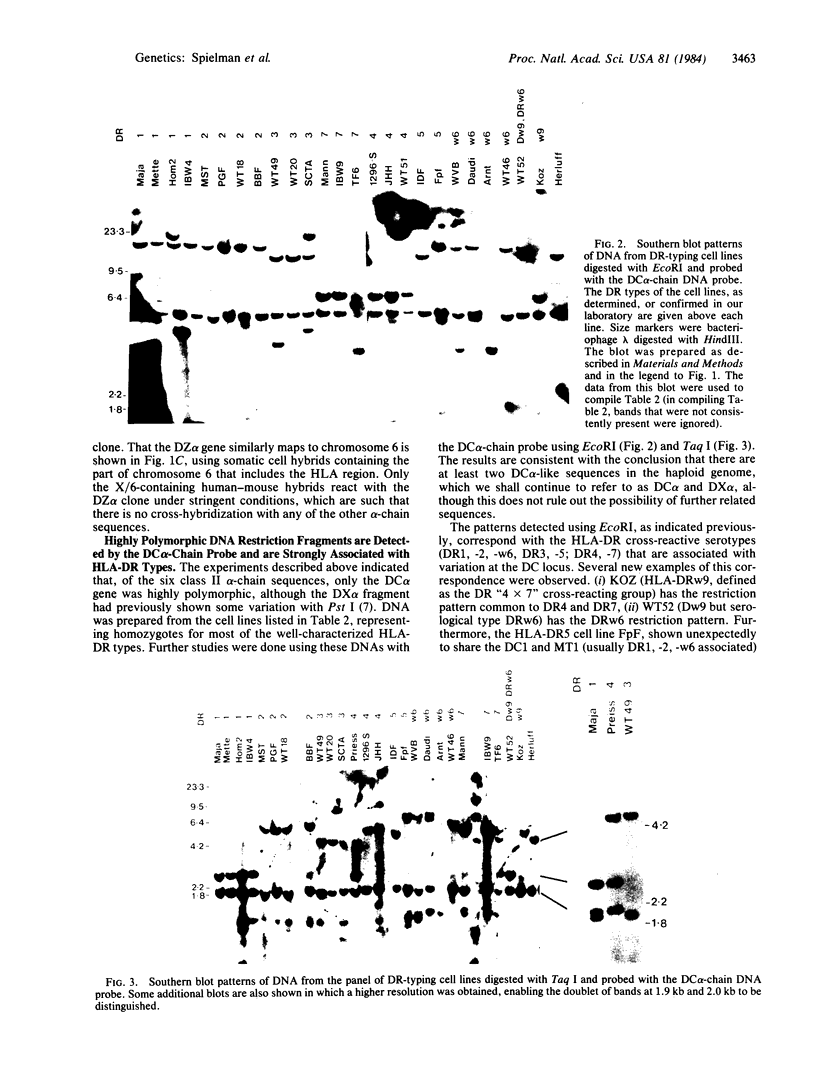
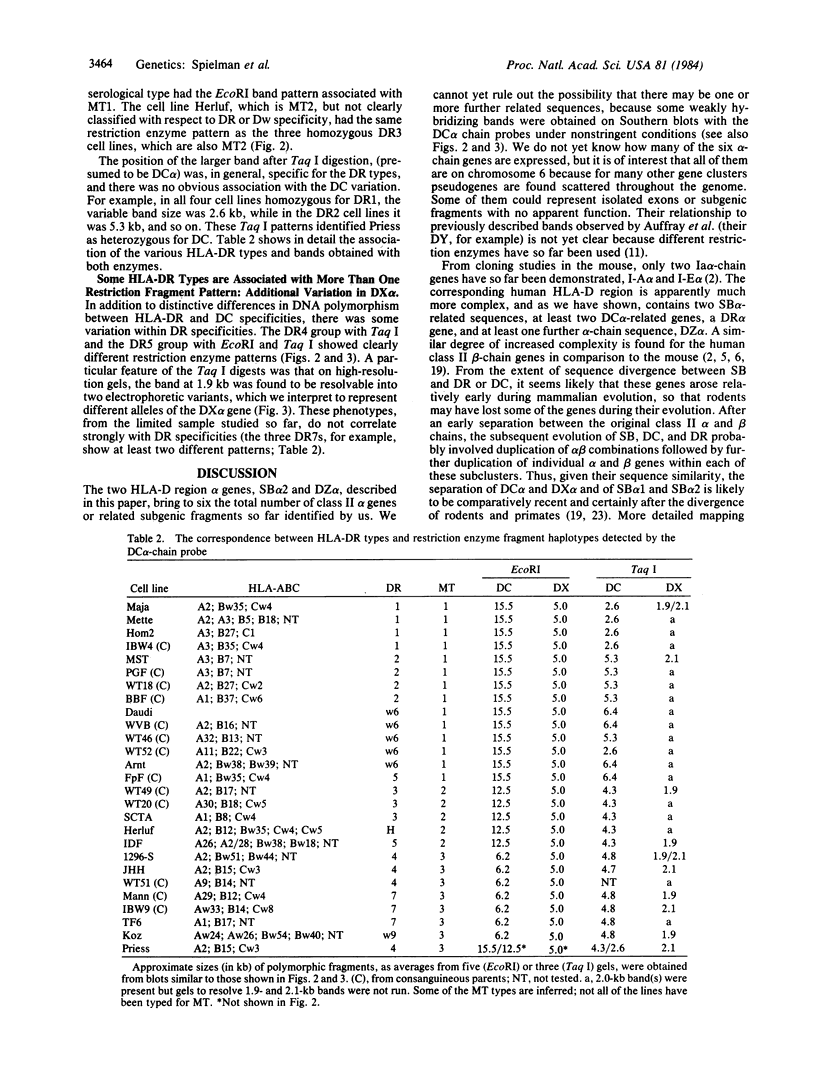
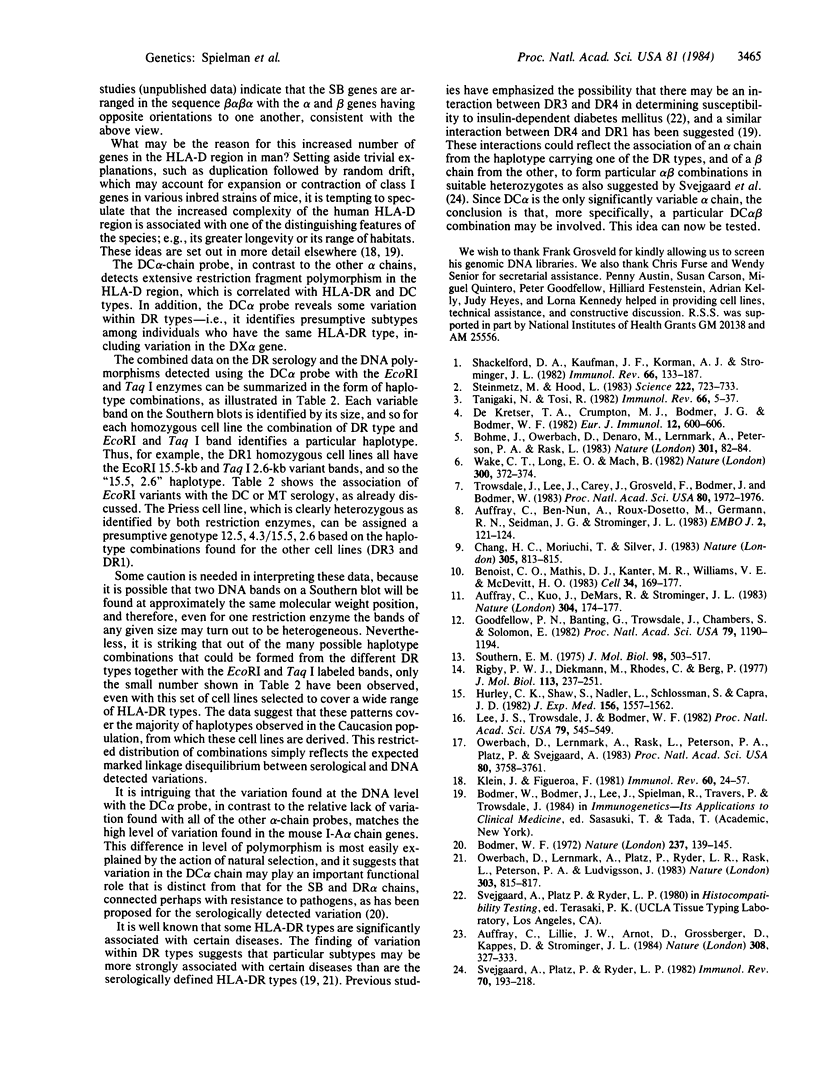
Images in this article
Selected References
These references are in PubMed. This may not be the complete list of references from this article.
- Auffray C., Ben-Nun A., Roux-Dosseto M., Germain R. N., Seidman J. G., Strominger J. L. Polymorphism and complexity of the human DC and murine I-A alpha chain genes. EMBO J. 1983;2(1):121–124. doi: 10.1002/j.1460-2075.1983.tb01392.x. [DOI] [PMC free article] [PubMed] [Google Scholar]
- Auffray C., Kuo J., DeMars R., Strominger J. L. A minimum of four human class II alpha-chain genes are encoded in the HLA region of chromosome 6. Nature. 1983 Jul 14;304(5922):174–177. doi: 10.1038/304174a0. [DOI] [PubMed] [Google Scholar]
- Auffray C., Lillie J. W., Arnot D., Grossberger D., Kappes D., Strominger J. L. Isotypic and allotypic variation of human class II histocompatibility antigen alpha-chain genes. Nature. 1984 Mar 22;308(5957):327–333. doi: 10.1038/308327a0. [DOI] [PubMed] [Google Scholar]
- Benoist C. O., Mathis D. J., Kanter M. R., Williams V. E., 2nd, McDevitt H. O. Regions of allelic hypervariability in the murine A alpha immune response gene. Cell. 1983 Aug;34(1):169–177. doi: 10.1016/0092-8674(83)90147-2. [DOI] [PubMed] [Google Scholar]
- Bodmer W. F. Evolutionary significance of the HL-A system. Nature. 1972 May 19;237(5351):139–passim. doi: 10.1038/237139a0. [DOI] [PubMed] [Google Scholar]
- Böhme J., Owerbach D., Denaro M., Lernmark A., Peterson P. A., Rask L. Human class II major histocompatibility antigen beta-chains are derived from at least three loci. Nature. 1983 Jan 6;301(5895):82–84. doi: 10.1038/301082a0. [DOI] [PubMed] [Google Scholar]
- Chang H. C., Moriuchi T., Silver J. The heavy chain of human B-cell alloantigen HLA-DS has a variable N-terminal region and a constant immunoglobulin-like region. 1983 Oct 27-Nov 2Nature. 305(5937):813–815. doi: 10.1038/305813a0. [DOI] [PubMed] [Google Scholar]
- De Kretser T. A., Crumpton M. J., Bodmer J. G., Bodmer W. F. Two-dimensional gel analysis of the polypeptides precipitated by a polymorphic HLA-DR1,2,w6 monoclonal antibody: evidence for a third locus. Eur J Immunol. 1982 Jul;12(7):600–606. doi: 10.1002/eji.1830120713. [DOI] [PubMed] [Google Scholar]
- Goodfellow P. N., Banting G., Trowsdale J., Chambers S., Solomon E. Introduction of a human X-6 translocation chromosome into a mouse teratocarcinoma: investigation of control of HLA-A, B, C expression. Proc Natl Acad Sci U S A. 1982 Feb;79(4):1190–1194. doi: 10.1073/pnas.79.4.1190. [DOI] [PMC free article] [PubMed] [Google Scholar]
- Hurley C. K., Shaw S., Nadler L., Schlossman S., Capra J. D. Alpha and beta chains of SB and DR antigens are structurally distinct. J Exp Med. 1982 Nov 1;156(5):1557–1562. doi: 10.1084/jem.156.5.1557. [DOI] [PMC free article] [PubMed] [Google Scholar]
- Klein J., Figueroa F. Polymorphism of the mouse H-2 loci. Immunol Rev. 1981;60:23–57. doi: 10.1111/j.1600-065x.1981.tb00361.x. [DOI] [PubMed] [Google Scholar]
- Lee J. S., Trowsdale J., Bodmer W. F. cDNA clones coding for the heavy chain of human HLA-DR antigen. Proc Natl Acad Sci U S A. 1982 Jan;79(2):545–549. doi: 10.1073/pnas.79.2.545. [DOI] [PMC free article] [PubMed] [Google Scholar]
- Owerbach D., Lernmark A., Platz P., Ryder L. P., Rask L., Peterson P. A., Ludvigsson J. HLA-D region beta-chain DNA endonuclease fragments differ between HLA-DR identical healthy and insulin-dependent diabetic individuals. Nature. 1983 Jun 30;303(5920):815–817. doi: 10.1038/303815a0. [DOI] [PubMed] [Google Scholar]
- Owerbach D., Lernmark A., Rask L., Peterson P. A., Platz P., Svejgaard A. Detection of HLA-D/DR-related DNA polymorphism in HLA-D homozygous typing cells. Proc Natl Acad Sci U S A. 1983 Jun;80(12):3758–3761. doi: 10.1073/pnas.80.12.3758. [DOI] [PMC free article] [PubMed] [Google Scholar]
- Rigby P. W., Dieckmann M., Rhodes C., Berg P. Labeling deoxyribonucleic acid to high specific activity in vitro by nick translation with DNA polymerase I. J Mol Biol. 1977 Jun 15;113(1):237–251. doi: 10.1016/0022-2836(77)90052-3. [DOI] [PubMed] [Google Scholar]
- Shackelford D. A., Kaufman J. F., Korman A. J., Strominger J. L. HLA-DR antigens: structure, separation of subpopulations, gene cloning and function. Immunol Rev. 1982;66:133–187. doi: 10.1111/j.1600-065x.1982.tb00437.x. [DOI] [PubMed] [Google Scholar]
- Southern E. M. Detection of specific sequences among DNA fragments separated by gel electrophoresis. J Mol Biol. 1975 Nov 5;98(3):503–517. doi: 10.1016/s0022-2836(75)80083-0. [DOI] [PubMed] [Google Scholar]
- Steinmetz M., Hood L. Genes of the major histocompatibility complex in mouse and man. Science. 1983 Nov 18;222(4625):727–733. doi: 10.1126/science.6356354. [DOI] [PubMed] [Google Scholar]
- Svejgaard A., Platz P., Ryder L. P. HLA and disease 1982--a survey. Immunol Rev. 1983;70:193–218. doi: 10.1111/j.1600-065x.1983.tb00715.x. [DOI] [PubMed] [Google Scholar]
- Tanigaki N., Tosi R. The genetic control of human Ia alloantigens: a three-loci model derived from the immunochemical analysis of 'supertypic' specificities. Immunol Rev. 1982;66:5–37. doi: 10.1111/j.1600-065x.1982.tb00432.x. [DOI] [PubMed] [Google Scholar]
- Trowsdale J., Lee J., Carey J., Grosveld F., Bodmer J., Bodmer W. Sequences related to HLA-DR alpha chain on human chromosome 6: restriction enzyme polymorphism detected with DC alpha chain probes. Proc Natl Acad Sci U S A. 1983 Apr;80(7):1972–1976. doi: 10.1073/pnas.80.7.1972. [DOI] [PMC free article] [PubMed] [Google Scholar]
- Wake C. T., Long E. O., Mach B. Allelic polymorphism and complexity of the genes for HLA-DR beta-chains--direct analysis by DNA-DNA hybridization. Nature. 1982 Nov 25;300(5890):372–374. doi: 10.1038/300372a0. [DOI] [PubMed] [Google Scholar]





